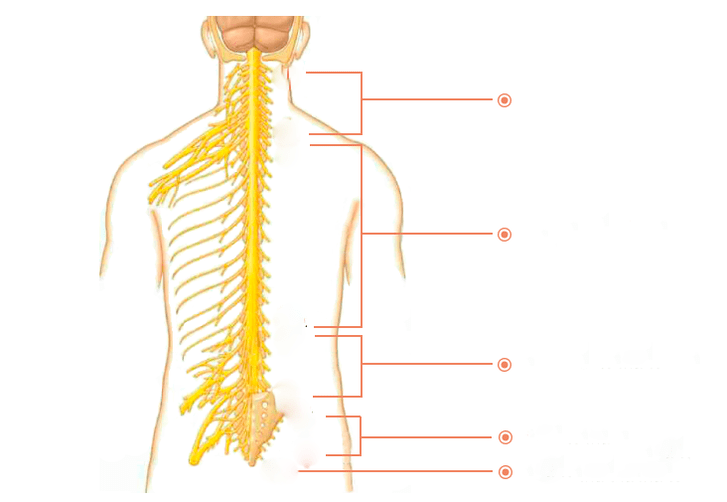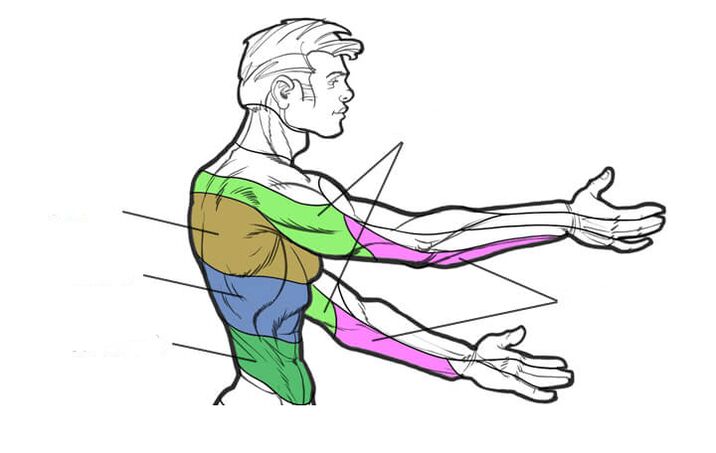The thoracic spine has a peculiarity - the ribs accompany it. Due to this, it is less mobile than the neck and lower back. As a result, osteochondrosis in the thoracic region develops less frequently, according to the principle: "less mobility - less wear. " But it develops less frequently - this does not mean it flows more easily. And indeed so. It's about chest pain. Because the thoracic spine pain zone coincides with the cardiac zone, symptoms are often confused with angina pectoris or myocardial infarction. No wonder they say about thoracic osteochondrosis that it is a "chameleon". After all, he can pretend not only to have heart disease, but also diseases of the lungs, liver, stomach, gallbladder or pancreas. And here you can not make mistakes and ignore heart attacks or other serious diseases, for example, pathology of the mammary glands in women. Mistakes like these are costly, even if they succeed in the end. After all, this can "drive" a person into severe stress. That is why it is very important to find an experienced and knowledgeable doctor who will understand everything and distinguish the symptoms of thoracic osteochondrosis from other pathologies. Symptoms of osteochondrosis of the thoracic region are usually divided into two categories - radicular and reflex.
Radicular symptoms
They arise because of the effect on the nerves coming out of the spine.
spinal cord

There are a lot of nerves coming out of the spine. They are called spinal nerves. Each of these nerves gradually branches and follows a specific area of the body with a clear boundary. This area is called the segmental innervation zone. Each vertebra, disc, nerve and zone is given a number that corresponds to each other. If a nerve is affected, symptoms will appear in the segmental conservation zone corresponding to this nerve, and not anywhere else-in an arbitrary place.
Radical symptoms include:
- Decreased or loss of reflexes;
- Violation of sensitivity;
- muscle weakness;
- It hurts then.
Conservation zone of the thoracic segment
Osteochondrosis D1 – D2- causes pain in the shoulders, collarbone and armpits.

Osteochondrosis D3 – D6- Causes pain, the character of the belt in the upper part of the chest. Simulates pain in the heart, angina pectoris attacks. In women, it causes pain in the mammary glands.
Osteochondrosis D7 – D8- causes pelvic pain at the level of the solar plexus. Simulates pain in the stomach, liver, gallbladder or pancreas. Reduces upper abdominal reflexes.
Osteochondrosis D9 – D10- causes pain in the hypochondrium and upper abdomen. Sometimes it mimics the so -called "acute" stomach - a sharp pain in the abdomen. Reduces the mid -abdominal reflex.
Osteochondrosis D11 – D12- causes pain in the groin. Simulates pain in gynecological diseases, appendicitis, intestinal diseases. Reduces lower abdominal reflexes.
Reflex symptoms
Unlike radicular, reflex symptoms have no clear boundaries. These can be: difficulty breathing, shortness of breath, pain during inhalation-exhalation, chills and "goosebumps" on the skin, intercostal neuralgia, belt pain in the chest. Dyspepsia is often observed - worsened appetite, nausea, heartburn, bloating, and stool disturbances occur. Due to pain, disturbed sleep, insomnia and feelings of insufficient sleep occur. Difficult to move, especially in the morning. Movement coordination is impaired - this is reflected in the gait. General weakness, weakness. Violations in the sexual sphere. Irritation. Rapid fatigue. There are many different types of pain. Pressing pain in the chest. Pain between the shoulder blades. Pain in the hypochondrium. Pain when raising hands. Pain when bending or trying to stand up straight. Pain between the shoulder blades. In general, pain in osteochondrosis of the thoracic region can be divided into two types.
Dorsalgia- moderate prolonged pain in the back and chest with periods of intensification and contraction.
Dorsago- acute pain "lumbago" in this area.
- The symptoms of osteochondrosis of the thoracic region depend on the stage of osteochondrosis.
- They get worse by bending or trying to stand up straight.
- Symptoms often appear after 35-45 years.
- It occurs about 3 times more often in women than men.
You, of course, notice that radicular symptoms are clearly defined, and reflex symptoms are very vague and non -specific. And as you know, all that lacks a clear definition serves as an easy cover for professional incompetence. This applies, among other things, to reflex symptoms and a favorite concept among physicians as "age -related changes". Surely many of you are familiar with the situation when the doctor explains the problem with a "reflex" or "age -related" process. Most people at moments like that rightly believe that doctors can’t figure out what’s going on and try to hide their incompetence in the fog of these "magic words".
At one point there was a popular phrase: "Every accident has a name, surname and position. " Every disease has its own symptoms. And the doctor's job is to know them clearly. And then there is no need to let the fog and blame osteochondrosis of the thoracic area for everything. Now you understand how important it is to find an experienced and knowledgeable doctor. Both a correct diagnosis and good treatment results will depend on this.
Diagnosis is the key to proper treatment
To date, there are several modern methods of hardware diagnostics of osteochondrosis. The most accurate are MRI and CT. But the main method is still clinical diagnostics - this is when an experienced doctor compares data from at least three sources - from patient complaints, MRI results and symptoms revealed by him during the examination. This allows you to make the most accurate diagnosis and create an effective individualized treatment program.
Treatment
As you understand, osteochondrosis is a real "tangle" of symptoms, unraveling which, the doctor will save you from pain and grief. But it is not possible to eliminate changes in the vertebrae and discs. Therefore, the word "osteochondrosis treatment" must be properly understood. If you are interested in eliminating pain and other suffering, then yes - it is quite possible. And if you conduct an academic discussion on the topic of restoring vertebrae and discs to their original appearance, "like a newborn", then no, the past cannot be restored. You have to be realistic, and then you will not fall for the bait of scammers.
Don't fall for the bait of scammers!
It is impossible to restore the vertebrae and discs to their original appearance!
What are the main treatment methods?
Gentle manual therapy is the main type of treatment for osteochondrosis of the thoracic region. It’s like an antibiotic for pneumonia - you can’t do without it. Other types - massage, medications, physiotherapy and exercise therapy - are additional.
How does gentle manual therapy work?
Disc nutrition is directly related to the muscles that surround the spine. In addition, the back muscles themselves are one of the causes of pain in osteochondrosis in the thoracic region. Gentle manual therapy is a special method that allows you to restore muscles to their natural physiology, eliminate cramps, muscle clamps and improve disc nutrition.
The intervertebral disc is the only part of the body that does not have blood vessels and is preserved to function properly by muscles.
In addition, when treating with the help of hands, chiropractors:
- remove the load from the affected vertebrae and discs and distribute them properly;
- relaxes muscles and helps them return to normal;
Therefore:
- rescuing patients from clamps;
- increase disk power;
- restore body motor function;
- normalize blood circulation.
The manual effect mobilizes the body’s internal powers and launches self -healing mechanisms.
The treatment is completely safe.
Prevention
To avoid recurrence, create comfortable conditions for you to sleep and work. Keep an eye on your weight and proper nutrition. Maintain your physical activity. But the main thing is not to neglect your health and do not save it. Don’t let the matter go by on its own. After recovery, try to do at least one gentle manual therapy maintenance session once every three to six months - this will reduce risk factors. Do not forget, neglected osteochondrosis leads to complications - protrusion and disc herniation. Remember: your health, first of all, you need!
Running osteochondrosis leads to complications - protrusion and herniation of the disc.













































